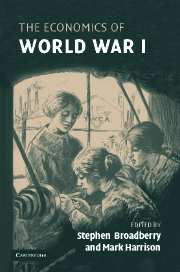Book contents
- Frontmatter
- Contents
- List of figures
- List of tables
- List of contributors
- Acknowledgements
- Introduction
- 1 The economics of World War I: an overview
- 2 The pity of peace: Germany's economy at war, 1914–1918 and beyond
- 3 Austria-Hungary's economy in World War I
- 4 The Ottoman economy in World War I
- 5 Between the devil and the deep blue sea: the Dutch economy during World War I
- 6 Was the Great War a watershed? The economics of World War I in France
- 7 The United Kingdom during World War I: business as usual?
- 8 Poor Russia, poor show: mobilising a backward economy for war, 1914–1917
- 9 Italy at war, 1915–1918
- 10 Until it's over, over there: the US economy in World War I
- Index
- References
7 - The United Kingdom during World War I: business as usual?
Published online by Cambridge University Press: 23 July 2009
- Frontmatter
- Contents
- List of figures
- List of tables
- List of contributors
- Acknowledgements
- Introduction
- 1 The economics of World War I: an overview
- 2 The pity of peace: Germany's economy at war, 1914–1918 and beyond
- 3 Austria-Hungary's economy in World War I
- 4 The Ottoman economy in World War I
- 5 Between the devil and the deep blue sea: the Dutch economy during World War I
- 6 Was the Great War a watershed? The economics of World War I in France
- 7 The United Kingdom during World War I: business as usual?
- 8 Poor Russia, poor show: mobilising a backward economy for war, 1914–1917
- 9 Italy at war, 1915–1918
- 10 Until it's over, over there: the US economy in World War I
- Index
- References
Summary
Throughout the war there were two phrases which must have been repeated hundreds of times … ‘Every private interest must be subordinated to the successful prosecution of the war’ and ‘There must be as little interference as possible with the normal channels of trade’ … The real problem was to determine the exact degree of interference with normal trade channels that was necessary for the successful prosecution of the war
(Lloyd, 1924: 259).Introduction
World War I transformed the British economy in the short run and had a significant impact on growth and development in the long run. In August 1914 there was little appreciation of the sheer scale of the war effort that would be needed to defeat the Central Powers. Similarly, few could imagine the scale of the sacrifice that the country would be called upon to make, in terms of both the number of men lost on the battlefield and the drain on national finances. Some historians have questioned whether the experience can be called a ‘total war’, but from an economic perspective the term is not too misleading, even though the degree of mobilisation in World War II would turn out to be even greater (Chickering and Förster, 2000; Broadberry and Howlett, 2005). As the war lengthened in duration and the war effort expanded, the tension highlighted by Lloyd (1924) between the initial desire to continue with ‘business as usual’ and the need for co-ordinated state intervention came to the fore.
- Type
- Chapter
- Information
- The Economics of World War I , pp. 206 - 234Publisher: Cambridge University PressPrint publication year: 2005
References
- 17
- Cited by

